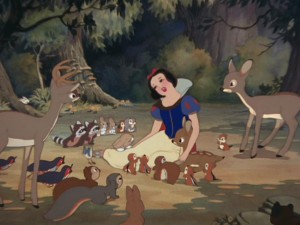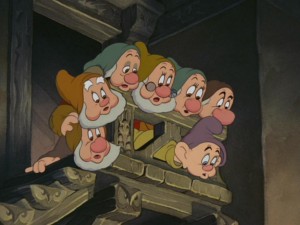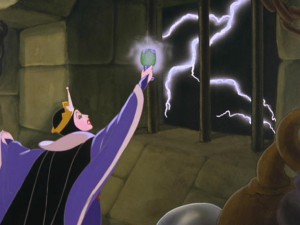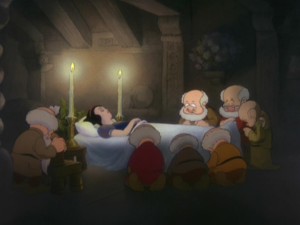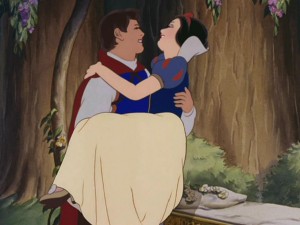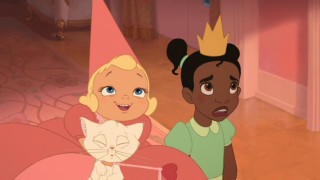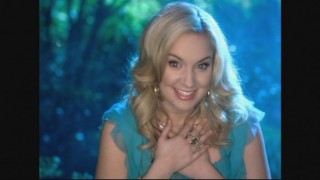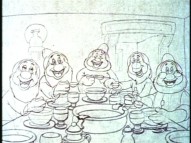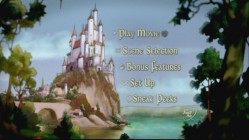Snow White and the Seven Dwarfs: Diamond Edition Blu-ray & DVD Review
 |
Snow White and the Seven Dwarfs
Theatrical Release: December 21, 1937 / Running Time: 83 Minutes / Rating: G Director: David Hand / Writers: Ted Sears, Richard Creedon, Otto Englander, Dick Rickard, Earl Hurd, Merrill De Maris, Dorothy Ann Blank, Webb Smith (story adaptation); Wilhelm & Jacob Grimm (fairy tales) Voice Cast (uncredited): Adriana Caselotti (Snow White), Lucille LaVerne (The Queen/Old Peddler Woman), Pinto Colvig (Sleepy, Grumpy), Billy Gilbert (Sneezy), Otis Harlan (Happy), Scotty Mattraw (Bashful), Roy Atwell (Doc), Eddie Collins (Dopey), Harry Stockwell (The Prince), Stuart Buchanan (The Huntsman), Moroni Olsen (The Magic Mirror) Songs: "I'm Wishing/One Song," "With a Smile and a Song," "Whistle While You Work," "Heigh-Ho", "Bluddle-Uddle-Um-Dum (The Washing Song)", "The Silly Song," "Someday My Prince Will Come" |
Buy Snow White and the Seven Dwarfs: Diamond Edition (2 Blu-ray Discs, 1 DVD) from Amazon.com in...
Blu-ray Packaging Deceptive DVD Packaging Collector's Book Set Seven Dwarf Plush Set Limited Edition Collector's Set
Buy New Standard 2-Disc DVD
By Kelvin Cedeno
It's a bit overwhelming to sit and ponder how much influence Disney has over modern day pop culture. It's prevalent in our everyday lives to the point where one can't go without running into something pertaining to this company. Walter Elias Disney opened the company's legacy with short subjects. What were charmingly crude cartoons soon developed into more finely-tuned miniature films. Knowing that they couldn't just thrive on these shorts, Walt had the idea to create a full-length animated feature film. Like Disney's power over pop culture today, one can take for granted just how radical an idea this was, especially with new animated features being sent to theaters every couple of months. There were many stories he considered for this innovative treatment, but Walt finally settled on the Brothers Grimm fairy tale of Snow White and the Seven Dwarfs.
Most should already be familiar with this tale, but for those who aren't, the story obviously concerns itself with a princess named Snow White (voiced by Adriana Caselotti). Her stepmother, the Queen (Lucille La Verne), is so obsessed with her own beauty that when a Magic Mirror (Moroni Olsen) reveals Snow White to be the fairest in the land, the Queen goes into a jealous rage. She arranges for her stepdaughter to be killed, but Snow White manages to escape deep in the forest, stumbling upon the home of seven dwarfs. The residents are Doc, Grumpy, Sleepy, Happy, Bashful, Sneezy, and Dopey. The story follows these title characters as Snow White acts as a maternal figure towards them, and they, in return, protect her from the Queen's murderous grasp.
What stands out most about Snow White and the Seven Dwarfs is its simplicity. There really isn't much to the story outside of the above synopsis, with most scenes existing to establish the characters. The locations are limited to the Queen's castle, the Dwarfs' cottage, and the forest that links them. In an era where rapid editing is all the rage, it's interesting to see just how long scenes go before the next one finally comes. For the most part, such a straightforward approach works in the film's favor. It gives the audience time to truly get to know the cast of characters, especially since the cast is slight in number compared to other features.
The relaxed pacing does have one unflattering side effect, however. In allowing the audience to spend so much time with Snow White, it becomes more apparent how little there is to her character. She doesn't actively take the story anywhere, and she doesn't seem to change or develop as a person at all throughout the story. Her purpose is merely to stand as a catalyst for those around her. Her existence allows for the Dwarfs to protect her and (for Grumpy, at least) to change themselves, and it gives the Queen a motivation. It seems the Disney team was so unsure of how an audience would sympathize with an animated character that they over-applied her sweetness. She comes across as more pandering and naοve than she probably ought to, and this causes the "With a Smile and a Song" and "Whistle While You Work" sequences to drag somewhat with no humans to offset her extreme kindness. It can be debated that the polar opposite approach taken in 1959's Sleeping Beauty (where the heroine barely has any screen time) is more effective since the audience can project whatever they want onto the brief, blank canvas on screen rather than being force-fed a one-note personality.
Thankfully, the other characters are rendered more evenly. This is ironic for the Dwarfs since they're supposed to be one-note personalities, but there's something oddly human about them. It's apparent that the animators were in their comfort zone with this group, as each one makes an indelible impression. Grumpy in particular holds more of the film's weight on his shoulders than one might notice at first. Being the antithesis of Snow White, he reacts to her cloying manner in a way that makes the cynics in the audience identify with him. As such, Snow White herself becomes easier to buy into when she's sharing screen time with the Dwarfs. As for the Queen, it's remarkable to note how little time is spent with her and yet those few scenes are powerful enough to keep her presence felt while she's off screen.
Both the animation and music are of such high quality that it's hard to believe how little time separated this from something like the rubbery Silly Symphony Goddess of Spring. Snow White, the Queen, the Prince, and the Huntsman are all animated to a realistic degree. There's subtlety in their movements and expressions not often found in today's character animation. The Dwarfs offer an interesting middle ground, where they're not animated too realistically nor too cartoonishly, and this gives the audience a good idea of how much they're supposed to invest in them. The usage of the multiplane camera is quite effective and is especially noticeable thanks to the clarity of this Blu-ray Disc. The songs and score are unique in how tightly they're woven into the story. Characters often speak dialogue in rhyme leading into a song, and the score is directly timed to on-screen action rather than just evoking a general mood.
Snow White and the Seven Dwarfs certainly deserves its status as a classic, but not just because it was, as Disney puts it, "the one that started it all." Innovation can only carry a picture so far before it's lost to time. Snow White is a classic because it still holds up well today. While not everything about it has aged well, most of it has to an astounding degree. The supporting characters are charming, the animation is aesthetically pleasing and immersive, and the score is memorable and effective. This satisfies on all levels and is impressive not just as a "first try" for Disney features, but as a film, period. Snow White made its DVD debut in 2001 as the launch of Disney's prestigious Platinum Collection. This line was made up of the company's 10 best-selling video titles (later expanded to 14) and designed to offer the most state-of-the-art presentations possible. Snow White's bountiful set made good on that promise, though Platinum Editions dwindled and became less groundbreaking as the series went on. When all was said and done, there were 13 films, with the 14th (Fantasia) moved to the replacement series: the Diamond Collection. Once again, Snow White kicks off that lineup. For all intents and purposes, this seems to be the Platinum Collection re-released to Blu-ray, with the key difference being Aladdin's ousting and Fantasia 2000's granted access. Will the Diamond Collection live up to what the Platinums started but couldn't finish? How does this Diamond Edition release of Snow White and the Seven Dwarfs compare to what most considered to be its definitive edition eight years ago? Read on to find out. |
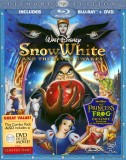 |
Blu-ray Disc Details1.33:1 Original Aspect Ratio (Windowboxed) or 1.78:1 with DisneyView
|
Buy Snow White and the Seven Dwarfs: Diamond Edition Blu-ray from Amazon.com in...
Blu-ray Packaging DVD Packaging Collector's Book Set Plush Gift Set Limited Edition Collector's Set
Check out our top picks for Disney collectibles
Related Reviews:
Related Countdowns:
DVDizzy.com | Disney's Animated Classics | Reviews | DVD & Blu-ray Release Schedule | Search
DVDizzy.com Top Stories:
Beauty and the Beast: Diamond Edition Blu-ray + DVD | Snow White and the Seven Dwarfs: Platinum Edition DVD
Disney's Next Features: Pinocchio (1940) Fantasia (1940) Dumbo (1941) Bambi (1942) Saludos Amigos & The Three Caballeros (1943-45)
Walt Disney Treasures - Pre-Snow White: Disney Rarities The Adventures of Oswald the Lucky Rabbit Silly Symphonies More Silly Symphonies
Platinum Edition DVDs - Disney Princesses: Cinderella (1950) Sleeping Beauty (1959) The Little Mermaid (1989)
Platinum Edition DVDs - 1950s & '60s: Peter Pan (1953) Lady and the Tramp (1955) 101 Dalmatians (1961) The Jungle Book (1967)
Platinum Edition DVDs - The '90s Renaissance: Beauty and the Beast (1991) Aladdin (1992) The Lion King (1994)
Disney Princess DVDs Featuring Snow White: Sing Along Songs: Once Upon a Dream Princess Stories: Tales of Friendship Princess Party: Vol. 1
New: Walt Disney Animation Collection: Classic Short Films, Volume 7 - Mickey's Christmas Carol A Muppets Christmas: Letters to Santa
Top 100 Disney Songs Top Disney Animated Classics Top Disney Villains Top Disney Heroes & Heroines
Screencaps of film and common bonus features are taken from 2009 Diamond Edition Blu-ray's Bonus DVD; others taken from 2001 Platinum Edition DVD.
